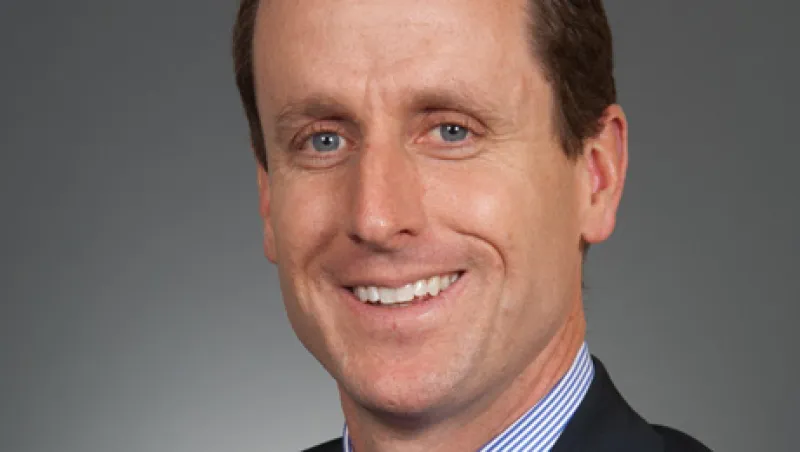With more than 3,000 independent registered investment adviser (RIA) practices using its custodial platform, Fidelity Investments has a front-row seat to changes in the industry. For five years now, Michael Durbin has led the firm’s institutional wealth services division, overseeing and expanding the business during a period of intense competition among adviser service providers. Institutional Investor caught up with Durbin to get his thoughts on the big adviser themes for 2014 (see also “Wealth Management M&A Appears to Continue Its Bullish Pace”).
Institutional Investor: The trend of consolidation and aggressive recruitment among investment advisers continued to pick up steam this past year. What’s driving that, and will it continue?
Durbin: There’s a bull market for advisers right now for three key reasons. First off, the number of practicing advisers has been shrinking during recent years. Second, the values of assets being advised or transacted upon by advisers, the principal way that practices are valued, have never been higher, especially in the case of fee-based advisers. And last but certainly not least, the demand, in my view, has never been higher due to demographics. It’s not just that the baby boomers are getting deeper into retirement, but also that Gen X and Gen Y professionals are achieving affluence. When you consider that complexities facing investors have never been higher — whether it’s health care, tax needs, estate or generational planning — more people are coming into the market for advice. Our view is that this incredible washtub of factors is producing strong market demand for advisers. So it’s a very positive backdrop.
So, in the near term, M&A among advisory firms will keep pace?
I do think that the current pace of consolidation will continue. There is a lot of discussion of late about courtship between firms. In terms of the pace of the actual dealmaking, I think it will continue. But the ratio of discussions to actual deals will remain pretty static, which means a lot more discussions than actual deals. Generally, there will continue to be more consolidation because it is viewed as one of the principal succession plans for an advisory firm. One critical element of the present consolidation is that most of the consolidators have third-party equity involved. Those investors at some point are going to seek a return on their money, so they are building a pipeline of larger deals to come.
So you believe that increasingly having to answer to outside shareholders will create a new dynamic within the business?
Absolutely. One very fundamental developing theme that we see is that business models continue to evolve rapidly. There is a steady pace of new and innovative adviser models coming into the marketplace. If we think about the bigger names, the more disruptive and innovative business models of today that didn’t exist even five years ago — firms like HighTower [Advisors], for example, or Dynasty Financial Partners, or even the rebirth of Robertson Stephens — there continues to be a pretty steady pace of not just new businesses but in those three cases, three fundamentally different and new business models. That’s a long-term positive for the industry. There seems to be a demonstrable shift toward turning these into businesses with enduring enterprise values.
What types of new services are these disruptive models demanding from custodial firms?
One clear thing is that there is a lot more going on in the technology space. We see this as a very healthy evolution of our industry. More innovations coming online are really going to make the advisers’ practice better. It’s going to help advisers target the clients that they want to target and run their business more efficiently. It’s going to help them grow faster. What technology innovation used to mean in this industry was just the latest set of bells and whistles. But today advisers are choosing technology not for the purpose of maximizing bells and whistles but for driving efficiency, driving growth. We’re trying to respond to this, for example, with an entirely cloud-based technology solution for advisory practices. We are trying to empower the “anywhere adviser,” where it’s possible to be an RIA through Fidelity and run your practice off an iPad. That may sound like just bells and whistles, but the efficiency that that can bring to a type of RIA practice is phenomenal (see also “How Investment Advisers Should (and Do) Use Social Media”).
Earlier, you mentioned the generational shift. How do you see that playing out for the RIA industry?
The RIA industry, like all financial intermediary channels, is at the moment powered by baby boomers. That generation has generally been comfortable delegating and working with advisers almost as they would listen to their physician. The mind-set has been, “I’m going to turn over discussion to the adviser, and the adviser is going to do what he or she thinks needs to be done in order to achieve my goals.” So, the baby boomers are still very important because they are fueling the business in terms of revenue and near-term growth. The future, however, rests on the generations behind them: Generations X and Y. They’re a bigger group combined than the boomers. What our proprietary research shows is that they’re going to behave very differently than their parents or grandparents when it comes to adviser services.
Can you provide some specific examples?
Our latest outlook showed that millionaires from these younger groups are “validators.” As surveyed, 61 percent of them will make their own decisions but work with at least one adviser for a “second” opinion. There is an adviser in the mix, so that’s good for the industry. But that adviser is principally in the mix to validate what that Gen X or Y investor wants to do already. In that same survey, only 6 percent indicated a desire to fully delegate their investment to an adviser. So, they still want to use them, just in a different way. Successful advisers are going to have to empower that validation. This new generation of investors is going to want to visit their money more often. They are going to want to talk to that adviser more frequently about their needs and portfolios and specific trades with a lot more transparency. The days of “Hey! Why don’t you and your [spouse] come to my office once a quarter, and I’ll take you through your quarterly report” are coming to an end. They want to be a lot more engaged in the process.
How do you see the investment approach developing as these bigger-picture changes take place?
There is this “barbelling” of adviser portfolios going on, with rapid growth of passive managers on one extreme and, with the success of liquid alternatives, very active management on the other. Underneath this, there is a trend of outsourcing money management. That trend quickened after 2008, when advisers worked like heck to maintain every single client relationship and still saw their revenue roll over by 20 percent because they bill on assets. Many of them realized, “I can’t retain my client, build my client and run portfolios simultaneously.” That produced an environment where many focused on business development and client relationship and had someone else to actually run money. I see continuation of all of that.
Get more on registered investment advisers.





